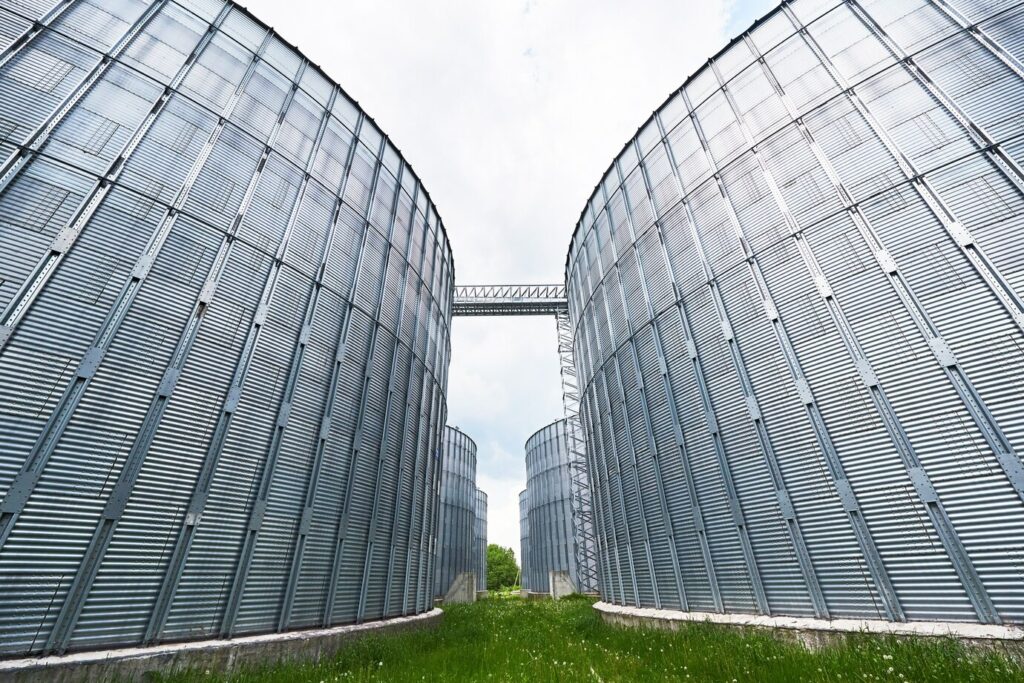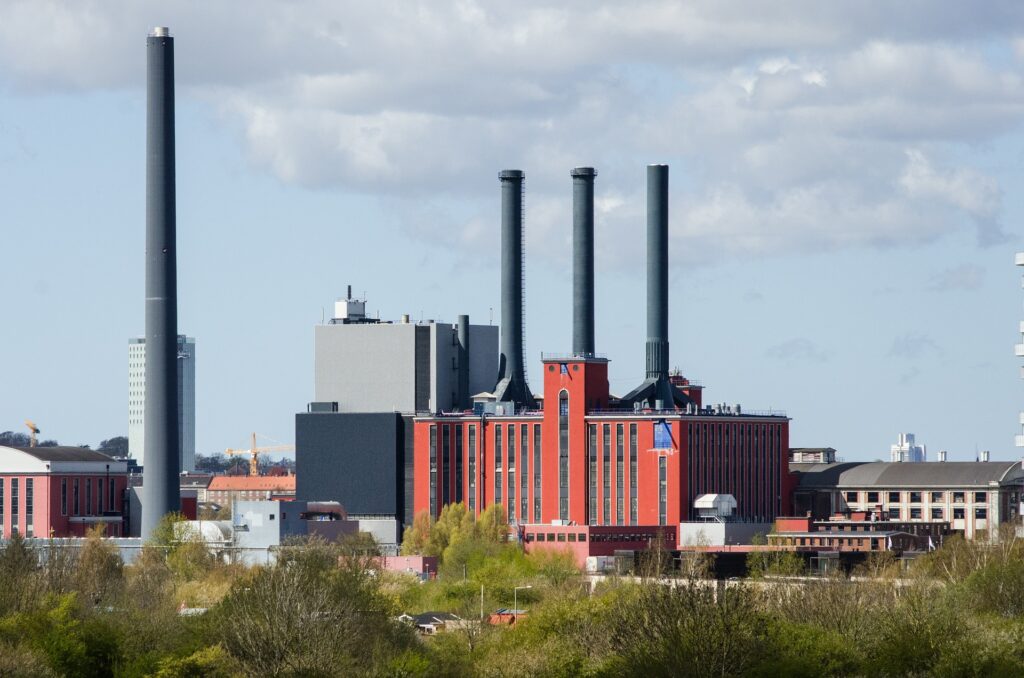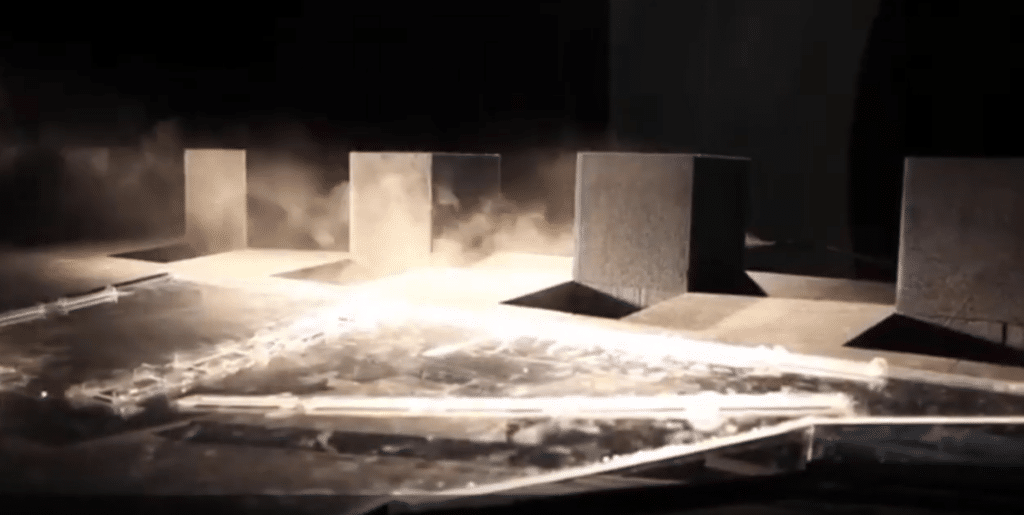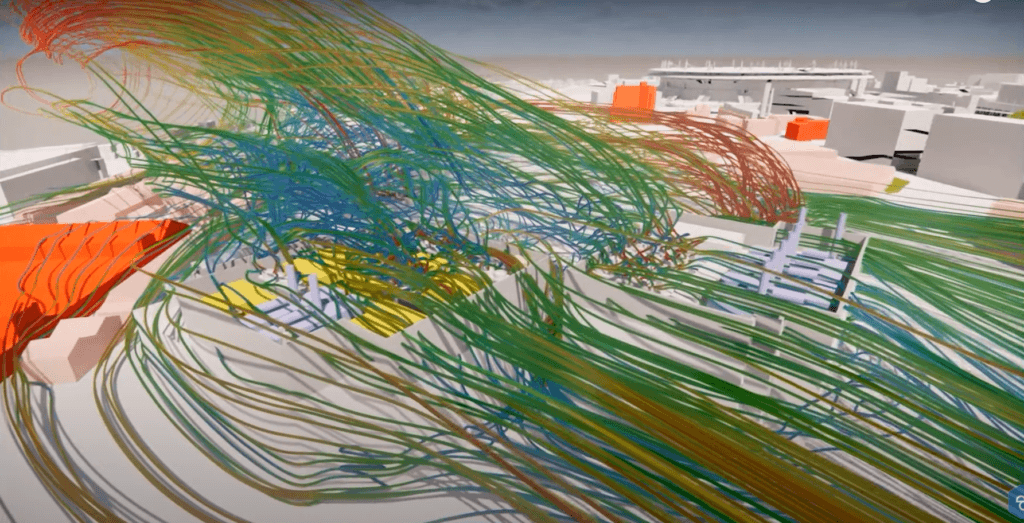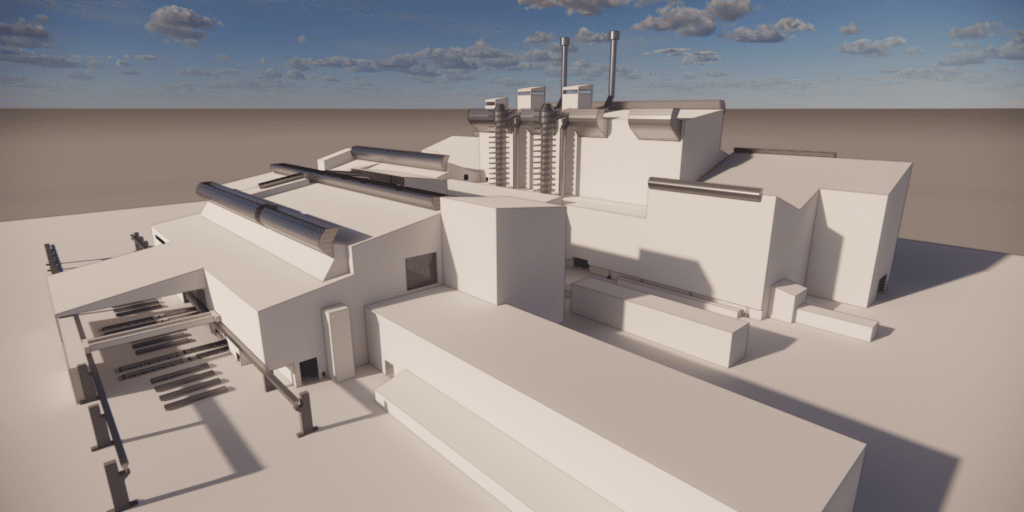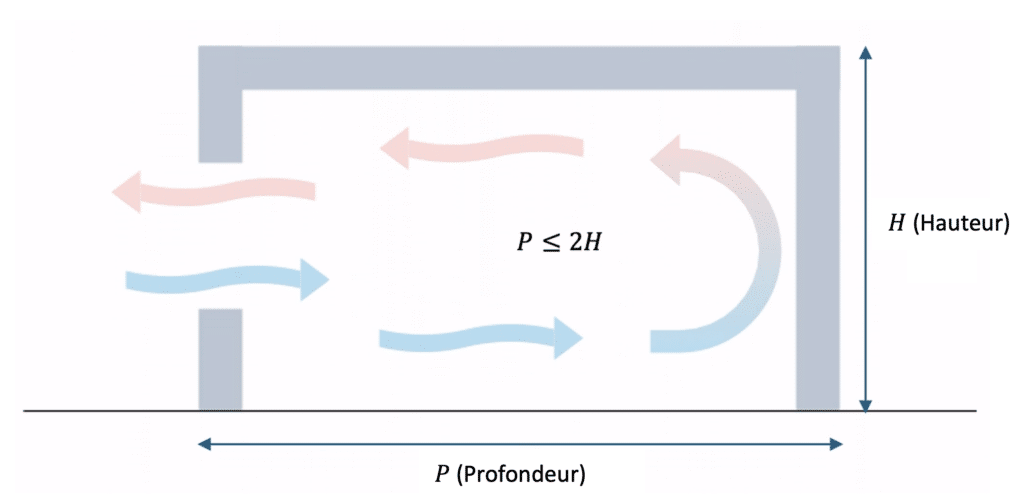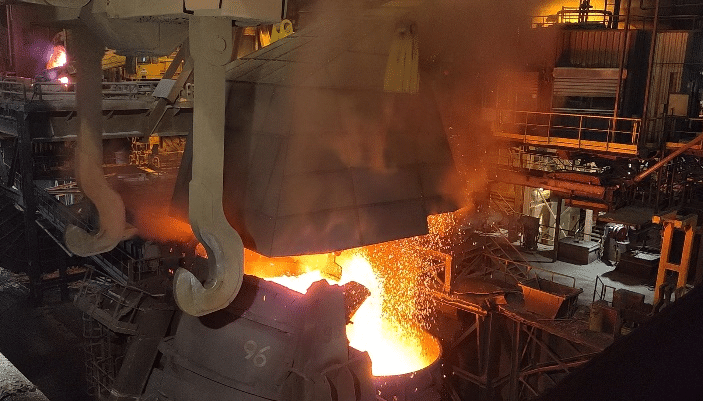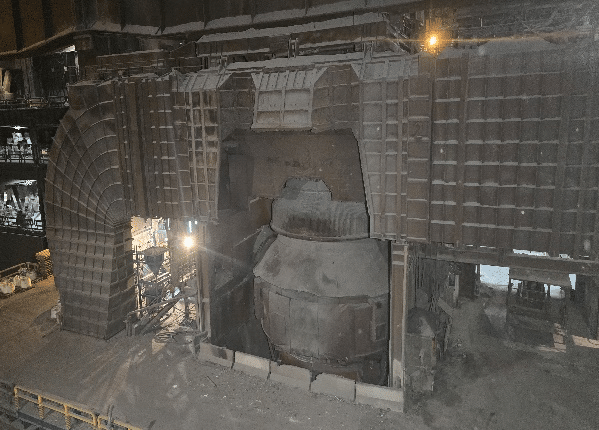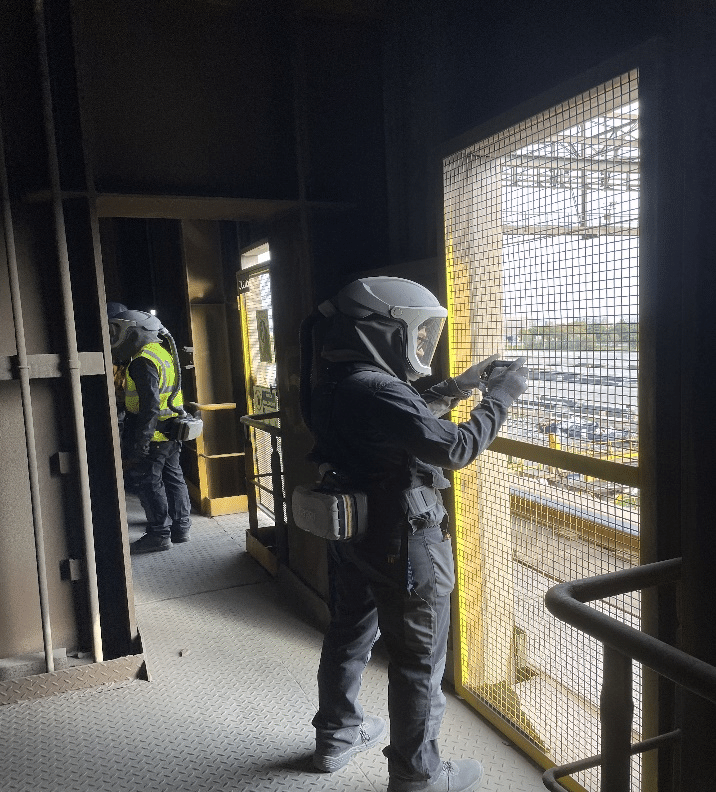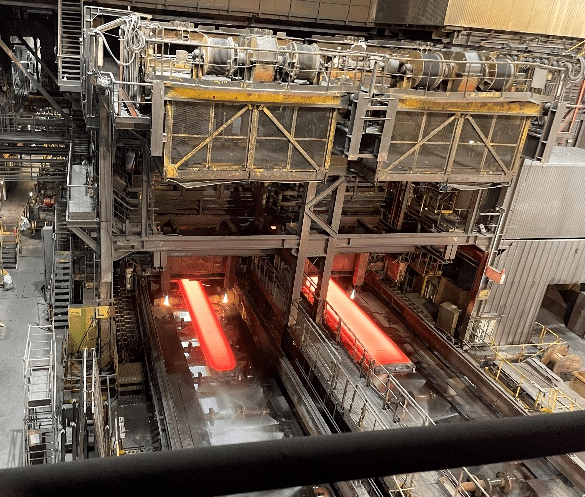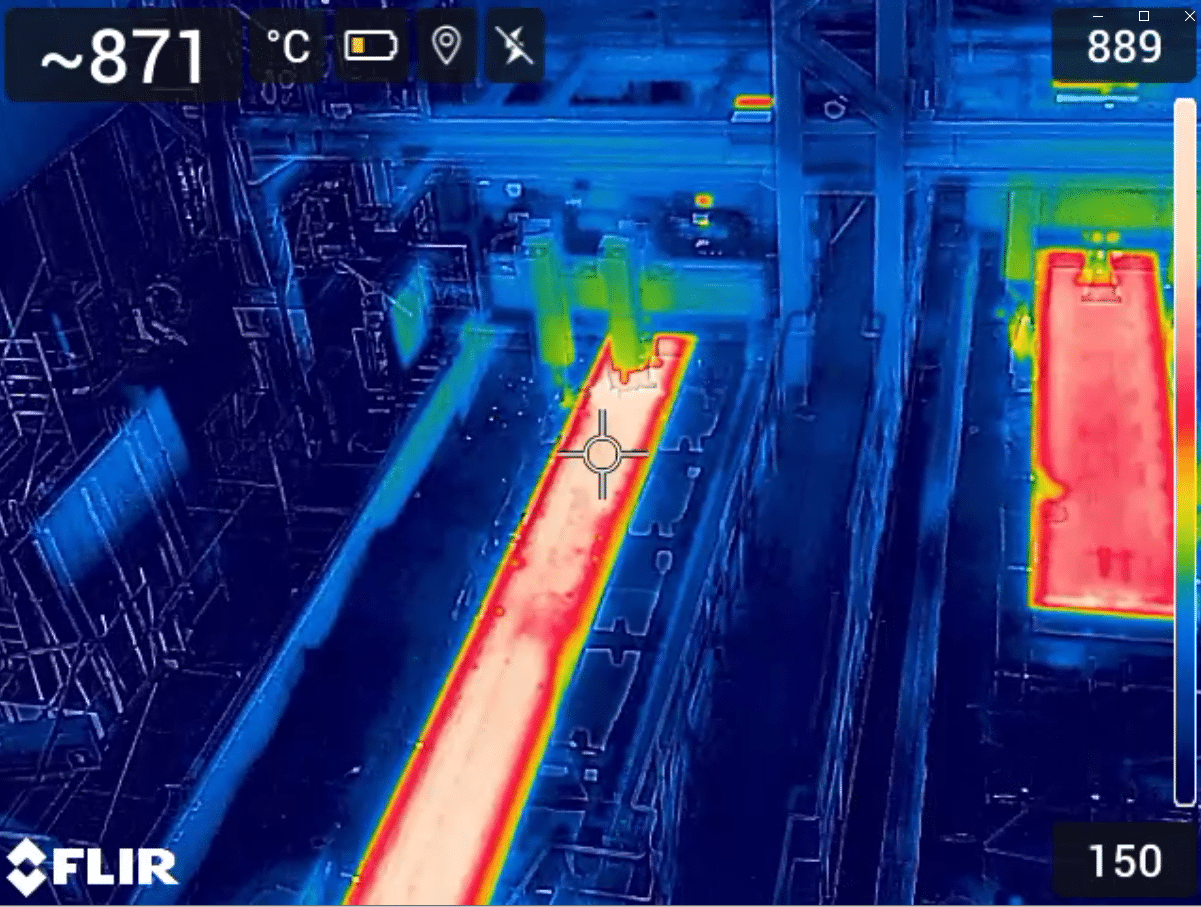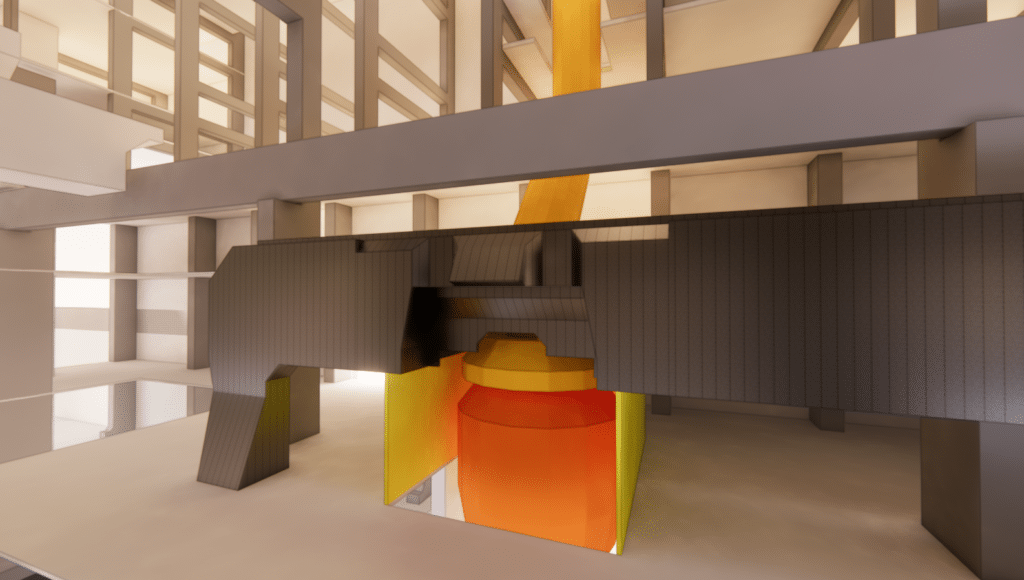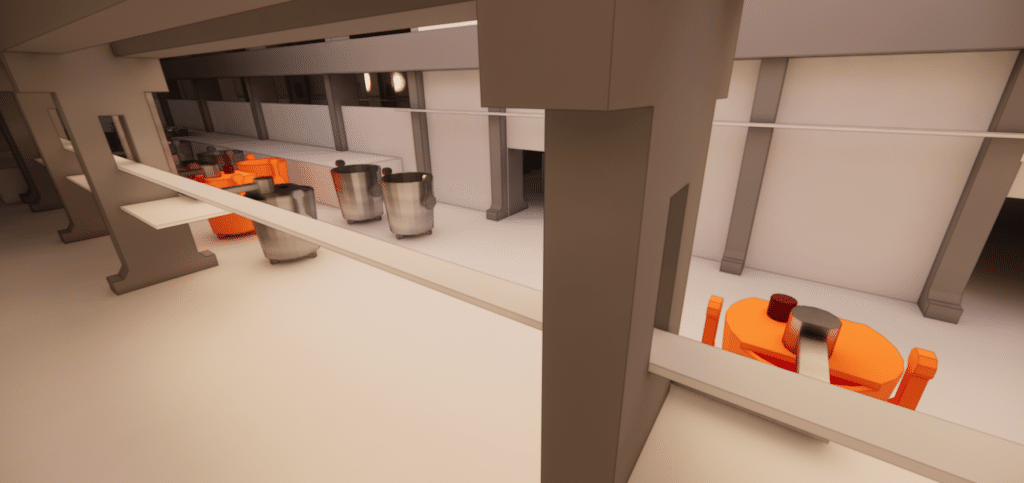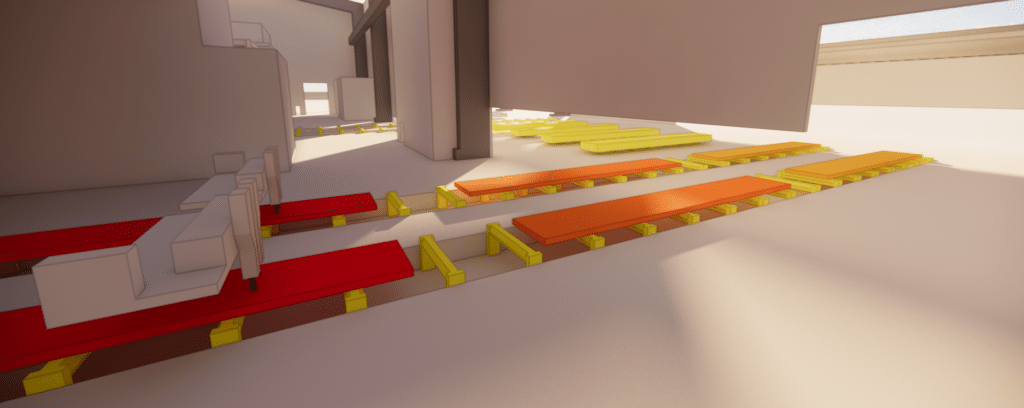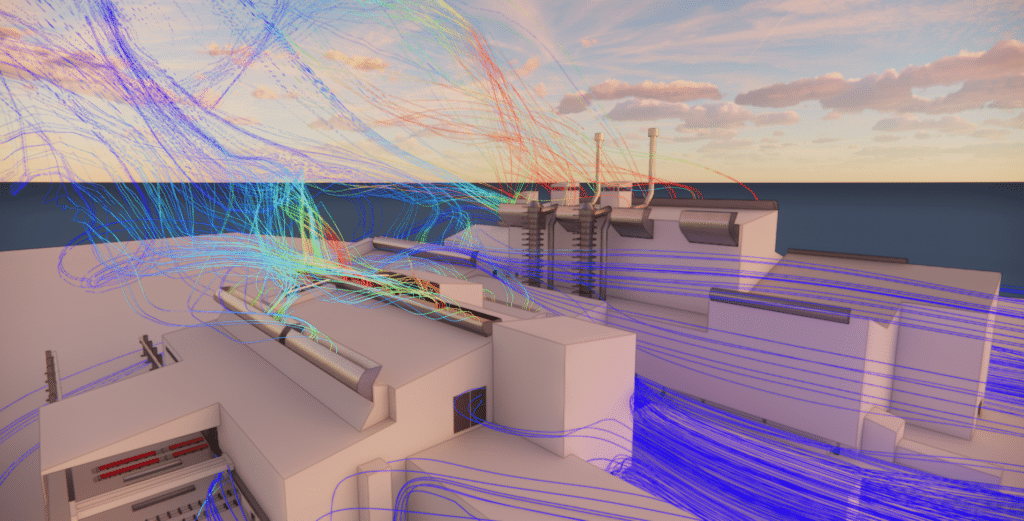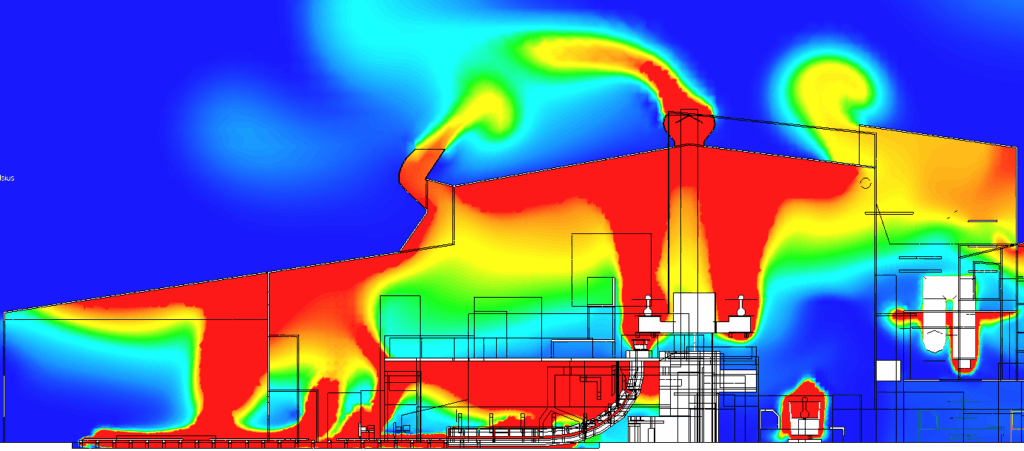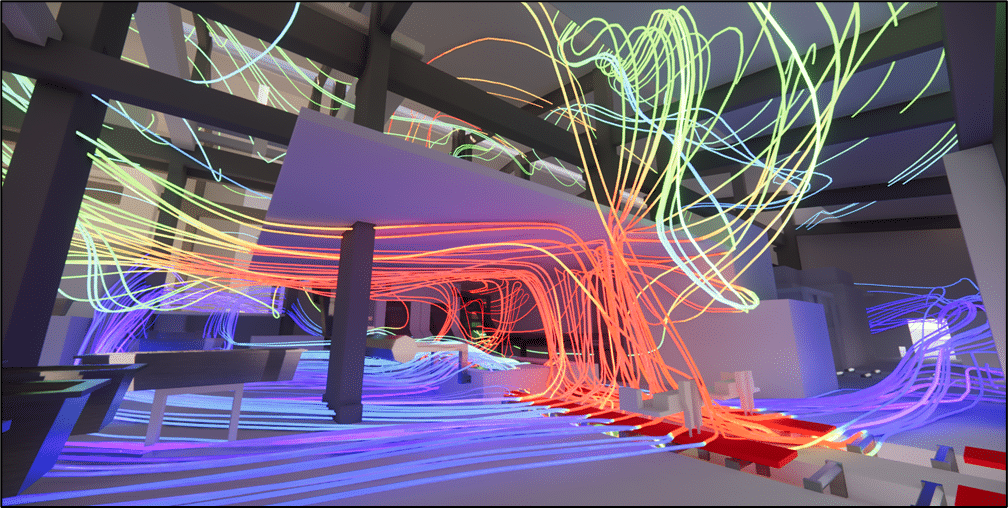Home » Industries » Industrial Natural Ventilation Design » Study of natural ventilation – Steelworks
Study of natural ventilation – Steelworks
Thermo-aerodynamic study of a steel plant
In an industrial environment subject to high heat and pollutant emissions, natural ventilation is showing its limits. Thanks to an analysis combining on-site surveys and CFD simulation, EOLIOS has studied the actual behavior of air flows and proposed concrete solutions to optimize ventilation, improve thermal comfort and enhance air quality in production areas.
Study of natural ventilation - Steelworks
Year
2025
Customer
NC
Location
Germany
Typology
Industry
Continue navigation :
Our other projects :
Latest news :
Technical file :
Our expertise:
An industrial challenge: controlling heat flow and dissipation
A highly constrained industrial site
At the heart of a steelworks that operates 24 hours a day, subject to extreme temperatures and massive emissions of metallurgical fumes. In this gigantic industrial hall, the heat generated by converters, ladles of molten metal and continuous casting calls for rigorous management of aeraulic flows.
The processes involved in transforming cast iron into steel also generate significant emissions of atmospheric pollutants, including carbon monoxide (CO), fine metallic dust, and compounds of manganese, chromium, zinc and crystalline silica. These fumes, often invisible to the naked eye, are all the more problematic as they can concentrate locally in the absence of effective extraction. In addition to the risks ofchronic exposure for operators, these pollutants are governed by strict Occupational Exposure Limits (OELs), requiring rigorous monitoring of air quality. In this context, ventilation plays a crucial role in rapidly evacuating noxious gases and diluting suspended particles, in order to maintain a working environment that complies with health and regulatory requirements.
With temperatures approaching 1,600°C and moving air volumes of several tens of thousands of cubic meters per hour,site ventilation relies on a complex balance between fume extraction and fresh air supply. Any disruption to this system can have an impact on air quality, operator safety and plantenergy efficiency.
Steel manufacturing process and impact on the aeraulic environment
Steel production relies on a series of energy-intensive industrial processes, generating large volumes of heat, gases and particles. Although each steel plant has its own specific characteristics, the general principle is based on the following steps:
Converters are charged with a mixture of liquid pig iron (from the blast furnace) and recycled scrap.
Injection of pure oxygen into the metal bath, eliminating excess carbon by oxidation, a reaction which generates large quantities of heat and metallurgical fumes.
Secondary metallurgy involves adjusting the chemical composition of steel by adding alloying elements (chromium, manganese, nickel, etc.).
Continuous casting, where liquid steel is poured into molds and gradually cooled with water to form solid slabs.
Cutting and finishing, possibly by plasma or laser, according to final specifications.
Video - Steel mill suction hood
Each stage contributes to the localized production of heat and pollutants, often concentrated around converters, ladle transfer zones, continuous casting or deslagging equipment. Working temperatures can exceed 1,600°C, generating rising hot air streams, gas fumes (CO, CO₂), fine particles and metallic dust. These phenomena have a direct impact on thermal stratification, airflow behavior and pollutant dispersion.
Understanding these mechanisms is essential for sizing a suitable ventilation system, capable of efficiently renewing the air, evacuating excess heat and limiting operator exposure.
Air quality and working environment
Production generates complex pollutants
The steelmaking process generates a wide variety of atmospheric pollutants, directly linked to the high temperatures and chemical reactions involved in converters and metallurgical treatments. The main compounds emitted are :
Carbon monoxide (CO), resulting from the oxidation of carbon contained in cast iron,
Fine and ultrafine metallic dusts, composed of iron, chromium, manganese or zinc,
Opaque fumes from deslagging, slab oxidation and casting operations,
Hot gases at very high temperatures, disrupting air dynamics.
These substances, sometimes invisible to the naked eye, can accumulate in high volumes or disperse slowly if no effective extraction mechanism is in place.
Strict regulatory thresholds: VLEPs
Regulations impose Occupational Exposure Limits (OELs ) to controlexposure to hazardous substances. These thresholds, expressed in mg/m³ or ppm, are designed to limit short- and long-term health effects (respiratory disorders, poisoning, chronic illnesses).
Compounds present in fumes, such as CO or metal particles, are strictly regulated. If these thresholds are exceeded, immediate corrective measures are required, such as source capture, localized ventilation, or the wearing of appropriate personal protective equipment (PPE).
Direct impact on operators' health
Chronic exposure to excessively high concentrations of pollutants can lead to respiratory pathologies, neurological disorders or systemic effects. Among the recognized risks in the steel industry:
Chronic bronchitis and dust-related pulmonary irritation,
CO poisoning, often insidious,
Neurotoxic effects of long-term manganese inhalation.
Controlling indoor air quality is therefore both a public health issue and a responsibility for the operator.
Measurement and assessment tools: a combined approach
During the audit, spot measurements were taken to characterize pollutants, particularly fine particles. However, some areas, such as those under roofs or near equipment, remain inaccessible.
To complete the picture, EOLIOS has implemented scalar CFD modeling, virtually reproducing :
Dispersion of gaseous and particulate pollutants,
The effects of ventilation on their dilution and extraction,
The location of critical concentration zones, depending on emission types and operating conditions.
This approach enables us toidentify risk areas requiring targeted corrective action.
Invaluable support for compliance and ventilation strategy
All the data collected, enhanced by CFD simulation, forms a solid basis for supporting regulatory procedures, in particular :
Drafting or updating the ICPE file,
Adapting the site to the requirements of the CMR directive,
Definition of a prevention plan for exposed operators,
Sizing ventilation systems, whether natural, mechanical or hybrid.
By providing measurable, comparable results, this approach enables you to make informed decisions that comply with both regulations and industrial operating constraints.
Natural ventilation: a constant challenge
Unlike other industrial environments where controlled mechanical ventilation systems ensure air renewal, this site relies mainly on natural ventilation. This type of ventilation is based on two fundamental physical principles: the temperature difference between inside and outside (creating a vertical thermal draught) and wind pressure on the building façades.
Thewarmer, lighterair naturally tends to rise and escape through the roof vents, while thecooler air enters through the lower openings. This passive, non-motorized approach takes advantage of natural conditions to ensure air renewal.
This mode of operation, although robust and economical, raises several major issues in an intensive industrial context:
Thermal discomfort for operators: when air flows are insufficient, heat accumulates under the roof and radiates into work areas. Conversely, in strong winds, local air speeds can become excessive, creating heat stress for exposed personnel.
Lack of control and complexity of design: unlike mechanical ventilation, natural ventilation does not allow precise adjustment of flow rates. Its design must anticipate airflow behaviour according to seasons, prevailing winds, building morphology and internal heat sources.
Pollutant emissions: pickling fumes, metal dust and process gases require efficient extraction. Without a structured flow, these pollutants can stagnate or be redistributed to sensitive areas.
Influence of weather conditions: the performance of natural ventilation is highly dependent on theoutdoor environment: wind direction and speed, sunshine, ambient temperatures…
In this context, the objective is clear: to understand how air circulates in the plant and identify levers for improvement to optimize ventilation, reduce exposure to fumes and guarantee a safer working environment.
Additional mechanical ventilation to capture air at source
While natural ventilation provides part of the general air renewal, it alone cannot guaranteerapid, localized evacuation of pollutants generated at production workstations.
This is why the site also relies on a targeted mechanical ventilation system, designed to extract critical emissions at their point of origin.
This principle is based on the use of extraction hoods, sensors or collection devices positioned as close as possible to emission sources: converters, furnaces, solid ladles, continuous casting, deslagging zones, etc. These systems capture fumes, gases or particles before they are dispersed into the working environment, limiting their spread throughout the hall.
Mechanical ventilation plays an indispensable complementary role here, particularly in areas where pollutant concentrations are highest. It also serves a regulatory purpose, as it keeps concentrations below VLEP (Valeurs Limites d’Exposition Professionnelle – Occupational Exposure Limits) thresholds.
However, this type of installation involves several technical constraints:
It requires precise dimensioning of extraction rates according to the intensity of emissions,
Its effectiveness is highly dependent on the configuration of the equipment and the proximity of the sensors,
It generates considerable energy consumption, which is why it’s important tocombine itintelligently with natural ventilation to create a balanced hybrid system that’s both efficient and economical.
The study carried out by EOLIOS takes into account this dual approach – natural and mechanical – to propose global optimizations that respect the site’s industrial, energy and health constraints.
A study in the service of aeraulic performance
To meet these challenges, EOLIOS carried out a complete thermo-aerodynamic study, combining on-site surveys and CFD digital simulations. This analysis made it possible to :
Map air flows inside the hall to understand the movement of warm air masses and pollutants,
Identify air inlet and outlet points, as well as areas where smoke stagnates,
Evaluate the efficiency of static aerators and louvers, to ensure optimum air renewal.
Thanks to this approach, EOLIOS is able to offer concrete solutions for improving natural site ventilation, drawing on the power of numerical simulations and its expertise in aeraulic engineering.
On-site immersion: The airflow audit in real-life conditions
Understanding air flows for better control
Before considering any optimization, it’s essential to understand exactly how the air circulates within the site. To achieve this, EOLIOS deployed a rigorous aeraulic audit methodology, combining on-site surveys and digital modeling. For several days, the engineers analyzed the behavior of air masses and the interactions between natural ventilation and industrial emissions.
The aim of the audit is to obtain a complete and detailed view of air movements, in order toidentify areas for improvement in ventilation and air renewal.
Analysis methodology: survey, test, observe
Temperature and air speed readings
The EOLIOS team carried out a detailed measurement campaign at various strategic points on the site. Using a calibrated anemometer, air velocities were measured at the building’s entry and exit points, as well as in the production halls. These data were used to quantify air flows and assess the intensity of natural air renewal.
At the same time, air temperature readings were taken at various heights. These measurements revealed a marked thermal stratification, typical of environments with high heat production: warm air accumulates at higher levels, while cooler air remains on the ground. These vertical gradients reflect the slow movement of warm air masses, which rise naturally but sometimes remain trapped under the roof in the absence of effective draught.
This detailed analysis has enabled us toidentify areas of thermal discomfort and poor ventilation, where natural extraction is insufficient.
Smoke tests: visualizing the invisible
One of the most telling tools is theuse of smoke tests, which enable the direction and speed of air flows to be visualized in real time.
EOLIOS used a cold-smoke machine suitable for industrial environments. By diffusing fine, light smoke in different areas, it was possible to trace the airflow path, pinpoint areas of stagnation or recirculation, and identify prevailing currents.
The results revealed several noteworthy phenomena:
Highly dynamic circulation around converters, full ladles and casting zones, where thermal draft is powerful,
Accumulations of smoke under the roof, indicating undersized or poorly distributed ventilators,
A strong influence of external conditions, particularly wind direction and intensity.
Video - Smoke tests in the steel mill
These visual observations provided a valuable basis for CFD modeling, enabling us to validate assumptions andadjust simulation parameters.
Analysis of heat transfer via infrared imaging
The thermal study is not limited to spot measurements: for an overall view of the thermal balance, EOLIOS has usedinfrared imaging.
Using a high-resolution thermal imaging camera, the engineers analyzed the surfaces of equipment and infrastructure in direct interaction with the air. This approach enabled us to identify :
The main sources of heat (converters, metal ladles, casting),
Natural heat dissipation zones,
Surfaces with high thermal inertia, where heat remains trapped.
These surveys were essential for defining the boundary conditions of the CFD model. Surface temperatures were used to calibrate heat flows, guaranteeing a simulation faithful to actual site behavior.
The results confirmed the need for optimized ventilation, capable ofevacuating excess heat while ensuring sufficient air renewal for a comfortable and safe working environment.
Photo and thermal image of the slab-forming area of the continuous caster
First observations: air flows to be optimized
Identifying and measuring ventilation openings
The aeraulic audit enabled us to identify and characterize all openings on the site: service doors, side vents, static roof ventilators and dust extraction hoods. Each opening was geo-referenced and measured to quantify its contribution to overall air renewal.
Air velocity measurements were taken at the inlet and outlet of these openings, to determine the actual flow rates exchanged. This characterization revealed significant disparities: some inlets are heavily used, while others remain little active, due to their position or the lack of pressure differential.
In particular, doors exposed to the prevailing wind experienced high air velocities, generating locally uncomfortable draughts for operators. These observations underline the need for a more even distribution of openings, but also for finer regulation to limit undesirable effects on thermal comfort at the workstation.
Mapping air currents and smoke stagnation zones
Surveys and smoke tests enabled us to draw up a detailed map of aeraulic flows in the production halls. This revealed several stagnation zones, where air is renewed more slowly and smoke tends to accumulate.
One area of particular concern is the roof space, where heat and fumes from industrial processes are concentrated without being efficiently evacuated. This phenomenon is accentuated by thermal stratification, which preventscool air from reaching the warmest areas.
Video - Smoke tests in the steel mill
Analysis of interactions between industrial processes and air flows
The study confirmed themajor impact of manufacturing processes on aeraulic dynamics. Molten metal transfers, deslagging sequences and continuous casting operations generate high heat and fume emissions, profoundly modifying air flows.
These phenomena need to be taken into account right from the design stage of natural ventilation systems, in order to promote smoke evacuation and reduce operator exposure to pollutants.
Understanding and modeling : The power of CFD simulations
From observation to model: faithfully reproducing industrial reality
Theaeraulic audit enabled us to collect a large amount of data on air movements, temperatures and smoke stagnation zones. To transform these observations into concrete recommendations, EOLIOS relies on a key tool: CFD (Computational Fluid Dynamics) simulation. This approach enables us to digitally reproduce the behavior of air and heat, with unrivalled accuracy in industrial environments.
The first step is to model the entire site in 3D. Based on site surveys, customer drawings andsatellite imagery, EOLIOS engineers reconstructed a complete geometric model, integrating the production halls and their immediate surroundings.
This model has been designed to preserve the site’s aeraulic complexity: all structures influencing air flows (walls, openings, frameworks, equipment, ventilators, etc.) have been faithfully integrated, while secondary elements have been simplified to optimize computing power.
Internal heat sources have also been carefully modeled. Each piece of equipment with a high heat input (converters, pockets, slabs, dryers, etc.) was parameterized on the basis of surface temperatures measured on site. This precision work makes it possible to reproduce the effects of thermal draught and the dynamics of rising warm air, essential in natural ventilation.
Finally, existing ventilation devices (louvers, ventilators, hoods) were included as boundary conditions, with flow rates or speeds taken from the audit. This model can be used not only toassess current system performance, but also to virtually test different configurations to guide design choices.
Simulate flows to predict, compare and optimize
Once the 3D model has been built, the simulation phase can begin. EOLIOS uses a numerical approach based on the finite element method to solve the equations governing air movement and heat exchange in the simulated volume. For this study, a very fine 3D hybrid mesh was generated, with specific refinement around areas of intense heat and openings.
A first series of calculations was carried out under steady-state conditions, modeling nominal operating conditions as observed during the audit. This scenario enabled us to validate the performance of the existing natural ventilation system andidentify critical areas for improvement.
The simulations highlighted several major phenomena:
Rapid ascent of warm air masses at converter and dryer level, with high vertical velocities,
Thermal stagnation zones under the roof, particularly around equipment that has been shut down,
Insufficient smoke extraction in some areas, due to poor thermal draught or unsuitable layout of openings.
These results have enabled us to draw up a detailed map of air flows, highlighting imbalances in renewal by sector.
Video - Temperature isosurface - Continuous casting (interior)
One of the great advantages of simulation is that it provides access to data that cannot be measured directly, such as :
Flow rates through roof vents, which cannot be safely instrumented,
Air velocities above equipment at over 1,200°C are very complex to instrument on site.
This information is crucial for validating the aeraulic balance, refining recommendations, and guaranteeing a complete analysis of airflow behavior throughout the site.
In addition to stationary calculations, certain critical zones were subjected to dynamic analysis under transient conditions, in order to better understand the evolution of flows and pollutant dispersion over time. This approach makes it possible to visualize the actual path of air and pollutants, depending on industrial activities, available openings and meteorological conditions. Using scalar tracers or emissivity lines (LÉS), these visualizations can be used toanticipate exposure peaks, smoke residence times, or areas of prolonged recirculation.
Video - Temperature Isosurface Steelworks
Explore scenarios to guide design choices
Beyond the initial observation, one of the major advantages of CFD simulation is that it enables rapid exploration of improvement scenarios, by virtually testing different modifications to the ventilation system without disrupting actual operation.
With this in mind, EOLIOS has simulated several alternative configurations, playing on :
Opening or closing existingvents,
Theaddition of extra aerators,
Modification of their positioning or orientation.
To guarantee the robustness of the solutions tested, the simulations were not limited to the weather conditions observed during the audit, but included several extreme scenarios:
A critical summer situation, with a low thermal gradient and high outdoor temperatures,
An unfavorable winter scenario, with a cold wind opposing the natural draught, having a major impact on smoke evacuation.
Variable thermal and pollutant load assumptions have also been incorporated:
A nominal situation, with a standard distribution of emissions,
A maximum unfavorable situation, where all emissive processes are active simultaneously, creating a critical accumulation of heat and pollutants.
Videos - Windless / Windy Temperature Isosurface
These simulations have enabled us toidentify the most efficient ventilation configurations, highlighting the key optimization levers.
Effective solutions include :
Reopening vents on façades exposed to prevailing winds, to let in fresh air,
Thetargeted addition of static roof ventilators, particularly in areas of thermal stagnation,
Better distribution of openings between halls, for more even ventilation without localized overpressure.
Thanks to these tests, it was possible to quantify the expected benefits precisely:
Increased extraction rates,
Reduced ambient temperatures,
Improved thermal comfort,
Reduced pollutant residence time.
Results are available in the form of temperature maps, air velocity maps, streamlines and comparative balances. They provide technical justification for design choices, while ensuring optimized performance under all operating conditions.
A decision-making tool and a lever for energy efficiency
The use of CFD simulation in this industrial context enables us not only to understand the current operation of the plant, but also to project its evolution and potential for improvement. It is a valuable decision-making tool for operators, design offices and safety managers.
By accurately identifying critical zones, airflow malfunctions and optimization opportunities, CFD enables :
Enhance operator safety, by ensuring rapid air renewal in areas with high pollutant emissions,
Improve thermal comfort, by reducing temperature variations and limiting overheating zones,
Reduce the site’s energy footprint, by optimizing natural ventilation to avoid the need for costly mechanical systems.
EOLIOS’ approach, based on precise field surveys, rigorous modeling and expert interpretation of results, enables us to propose concrete solutions adapted to each site configuration. It is this synergy between field expertise and numerical simulation that is the strength of the aeraulic studies carried out by EOLIOS in complex industrial environments.
Towards high-performance ventilation adapted to industrial challenges
A complete map to understand and act
One of the major benefits of CFD simulation lies in its ability to accurately visualize air movements within a complex industrial environment. Thanks to the calculations carried out, EOLIOS was able to draw up a detailed map of air flows, streamlines, stagnation zones and flows through the entire volume studied.
Areas of high thermal draught, close to converters, full pockets or hot slabs, result in rapid rises in hot air, partially channelled to roof vents. However, several critical areas have been identified:
Thermal stratification under the roof, particularly pronounced in poorly ventilated halls, where warm air accumulates without efficient evacuation,
Recirculation zones, particularly in corners or areas away from the main flow, wherestale air can stagnate,
Unbalanced ventilation between halls, with some benefiting from high airflow rates while others remain under-supplied with fresh air.
These observations have enabled us to pinpoint the malfunctions in the current system and measure their impact on air quality and thermal comfort.
Thermal stratification under the roof, particularly pronounced in poorly ventilated halls, where warm air accumulates without efficient evacuation,
Recirculation zones, particularly in corners or areas away from the main flow, wherestale air can stagnate,
Unbalanced ventilation between halls, with some benefiting from high airflow rates while others remain under-supplied with fresh air.
Scenario studies: maximum load, extreme conditions
To ensure the robustness of the solutions envisaged, the simulations were extended by the study of several unfavorable scenarios, going beyond the nominal conditions observed during the audit:
Extreme climatic scenarios, with very weak winds in summer, limiting natural draft, or violent winds in winter, generating pressure imbalances in the building,
Maximum heat and pollutant load scenarios, modeling a situation in which all emissive processes (casting, converters, ladles, etc.) are active simultaneously, generating a critical accumulation of heat and pollutants.
Although these are one-off situations, they enable us to test the resilience of the ventilation system and to size openings to guarantee minimum air renewal in all circumstances.
Optimizing ventilation systems: concrete solutions
Based on these analyses, EOLIOS tested and compared several optimization scenarios, virtually adjusting the ventilation systems:
Reopening of inactive or lightly used louvers on façades exposed to the prevailing wind,
Addition of static aerators in stagnation zones,
More even distribution of openings between the different halls,
Recalibration of certain mechanical extractions or source capture systems.
One of the most effective scenarios was to increase the air intake area on windward façades and install new roof vents. This configuration enabled :
A significant increase in extracted air flows in key zones,
Significantly lower ambient temperatures in work areas,
A marked reduction in the time spent by pollutants in indoor spaces.
These results demonstrate that targeted action on openings can transform the aeraulic behaviour of a site, without heavy investment or major interruption to production.
Air quality and pollutant control: a health issue
The study also made it possible to characterize indoor air quality andanticipate operator exposure to the various pollutants generated by the steelmaking process. These include :
Carbon monoxide (CO),
Fine and ultrafine metallic dusts (manganese, chromium, zinc),
Fumes from deslagging,slab oxidation and secondary metallurgy.
These pollutants are governed by Occupational Exposure Limit Values (OELVs), which impose strict concentration thresholds in the air. The simulation included scalar CFD studies, reproducing pollutant dispersion according to several ventilation scenarios.
The results highlighted :
Areas of high concentration under roofs and near active processes,
Slow dispersion of pollutants when natural ventilation is inadequate,
Localized exposure risks for operators close to sources.
These analyses were cross-referenced with the audit results and regulatory references, to determine the need for personal protective equipment (PPE), source capture, and targeted ventilation reinforcements in certain areas.
These elements also provide invaluable support for an ICPE installation or compliance file, if required.
Towards a controlled industrial ventilation strategy
By combining field data, numerical simulations and safety requirements, EOLIOS was able to propose a global ventilation strategy, perfectly adapted to the site’s specificities:
An optimized natural ventilation architecture, exploiting thermal draught and prevailing winds,
Rebalancing of air flows between different production zones,
A measurable reduction in temperatures and pollutant concentrations,
Better protection for operators, in compliance with VLEP and current standards.
This strategy can be implemented gradually, through simple, pragmatic actions, to build a ventilation system that is robust, sustainable and compatible with the site’s future development.
Continue on this topic
Video summary of the study
Summary of the study
In an industrial environment subject to high heat and pollutant emissions, natural ventilation is showing its limits. Thanks to an analysis combining on-site surveys and CFD simulation, EOLIOS has studied the actual behavior of air flows and proposed concrete solutions to optimize ventilation, improve thermal comfort and enhance air quality in production areas.
Video summary of the mission
Discover other projects
Radiation and ventilation study of an industrial ingot mould
Study of natural ventilation – Steelworks
Air quality improvement – Plant
Sizing – Chimney – Laboratory
High-temperature process plant
Natural ventilation – Metallurgy
Glassworks – Cognac
Natural ventilation – Aluminium Dunkerque
Smoke treatment system – CO2
VOC treatment process improvement
Sizing an industrial chimney – Furnace
Improving thermal comfort – Steelworks
Plant – Wind turbine
Industrial Workshop – Mexico
Factory – glove production
Stratification of a thermal storage tank
Generator sets – GE1
Glassworks – Hauts De France
Sizing of natural draft extractor hoods

